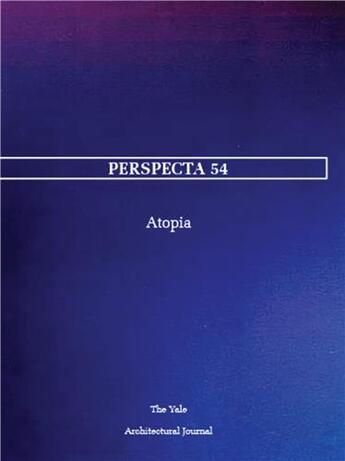Des idées de lecture pour ce début d'année !
Passionné(e) de lecture ? Inscrivez-vous
gratuitement ou connectez-vous pour rejoindre la
communauté et bénéficier de toutes les fonctionnalités du site !

Atopia as both the site of architecture's critical confrontation with hegemonic systems and the theoretical space in which its own processes can be challenged.
A literal no-place, atopia represents the spatial end-product of a society seemingly flattened by supra-territorial flows of information and material. It expresses both a physical artifact and condition of mass culture, and like the global systems of production and consumption from which it is conceived, atopia is both nowhere and everywhere at once. For the contributors of Perspecta 54, the ephemeral conditions of atopia are also an invitation to an equally unconstrained critical practice. Blurred boundaries--geopolitical, virtual, technical, disciplinary--offer sites for transgressive speculation and critique from beyond the limits of traditional design agency.
What results is a form of design practice that ambiguously straddles impossibility and hyperreality. Atopia rejects both the escapist fantasy of utopia and the nihilism of dystopia, favoring instead a conceptual middle ground from which real-world conditions can be productively engaged and challenged. Architecture's traditional objectives of critical inquiry--particularly the location of modes of complicity, agency, and resistance within larger structures--are mediated and reframed through nontraditional strategies of speculative design and fiction. For a profession that is routinely asked to navigate extreme complexity with limited tools, this approach suggests an expanded operational domain and possibilities for reinvigorated creative thought. From urban crises and climate emergencies to border disputes and geopolitics, Perspecta 54 examines atopia as both the site of architecture's critical confrontation with hegemonic systems and the theoretical space in which its own processes can be challenged.
Il n'y a pas encore de discussion sur ce livre
Soyez le premier à en lancer une !

Des idées de lecture pour ce début d'année !

Si certaines sont impressionnantes et effrayantes, d'autres sont drôles et rassurantes !

A gagner : la BD jeunesse adaptée du classique de Mary Shelley !

Caraïbes, 1492. "Ce sont ceux qui ont posé le pied sur ces terres qui ont amené la barbarie, la torture, la cruauté, la destruction des lieux, la mort..."